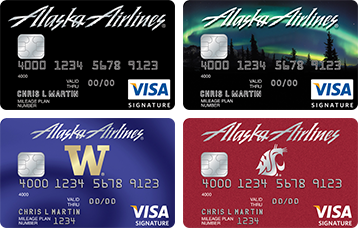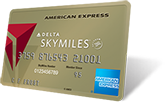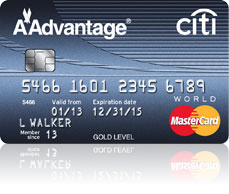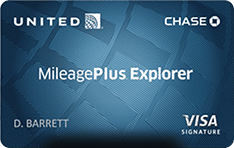Go Affiliated or Non-Affiliated CC?
A big discussion going on amongst many savvy frequent flyers is whether to use an affiliated card for your favorite airline or to use a non-affiliated one where you can apply the miles to any airline. Let’s analyze the pros and cons then you can decide for yourself. Note that I am not counting on all the mileage bonuses you can earn since those vary by card and time of the year. This focus is what you actually keep in your wallet and use on spending beyond manufactured spending.
Affiliated cards all have a similar scheme. In general, you earn two miles per $ spent on a given airline’s products and one mile per $ on everything else that you use the card on. Several have specialized categories such as gas or restaurants where they also give you a bonus. A notable exception is the BoA Alaska Airlines card which gives you three miles per $ for airline products. Here are some common cards:
Alaska Airlines VISA from BoA (annual fee $75)
As mentioned, AS gives three miles per $ spent on Alaska Airlines and one per $ spent on everything else. Extra earning, but also a great deal if you have a spouse/ SO/ FF buddy in the $99 companion fare. So two of you can fly the same itinerary for just $99 + taxes extra. Unlike some other companion tickets, you BOTH earn miles. Here is a tip, even if you do not collect AS miles, you can use this for AS flights and then credit the miles to DL or AA and they are EQM.
Delta Gold American Express ($95 annual fee)
This card is very typical of the airline CCs: two miles per $ on Delta spending and one mile per $ on everything else. It does have the common benefits of a free bag and priority boarding. If you already have Silver status, this gets you nothing and why are you choosing the Delta card if you do not already fly enough to make Silver?
American Airlines Citi MasterCard ($95 annual fee)
Again, two miles per AA $ and one mile per $ of everything else, one free checked bag and priority boarding. However, in addition, you get 25% off of on-board purchases and a 10% rebate when you redeem your AA miles.
United Airlines Explorer Card from Chase ($95 annual fee)
So same two miles per UA $ and one mile for every other $, one checked bag and priority boarding. In addition, two UA club passes, no foreign transaction fees, and a 10k mile bonus or spending over $25k a year.
So pretty typical as you would expect since they all need to be competitive with each other. Alaska is more generous, but they need to be to get people to fly a non-major airline.
Now let’s compare these to the non-affiliated cards which allow you to accumulate miles in their programs and use on any ticket for redemption.
Chase Sapphire Preferred ($95 annual fee)
So similar to the affiliated cards, you get two miles per $ spent on airfare, and restaurants. You get an additional mile per $ if you buy hotel or airfare through their portal. Other benefits at no foreign transaction fees and a 20% rebate if you buy airfare through their portal. Note that miles are valued at $0.01/ mile but buying through the portal bumps this up to $0.125/mile. This is less than the most common valuation of airline miles at $0.015 – 0.020/mile, but you can shop for a variety of airlines. Flexibility is worth something. Also of note, you can transfer these miles to several major hotel programs. You can also transfer 1:1 to British Airways, Korean Airlines, United, Virgin Atlantic or Southwest.
Capital One VentureOne Card ($0 annual fee)
This card only earns 1.25 miles per $ spent regardless of category. Miles transferable to any airline or hotel. Seems low, but you also are getting this card for free.
This post is getting a little long so let’s take that as a sample.
Affiliated cards:
PRO – Even if you value airlines miles at the low end of $0.015/mile, that is still equal to 3% back on your purchases for airline tickets. If you do not have status, the free bag is going to be equal to about $25 back on each flight. Really good if you are the type of person with no status and takes a lot of short flights meaning a lot of baggage charges before you will get status. The Alaska Airlines companion cert is one of the best deals out there and worth getting the card even if you don’t usually fly AS.
CON – Obviously the biggest downside is that you are getting miles in a single program which really ties you down to that airline. That may be OK with you if you live in a certain location which is dominated by one airline. These also have a downside with the annual fee as you may not be charging enough to make the annual fee worthwhile. If you are not making at least 10,000 miles from purchases (not bonuses) then I wouldn’t bother with that card unless you can get it for free. See Andy’s many posts on getting your credit card for free if you are currently serving, Amex, Chase, Citi, Barclays, and Capital One.
Non-Affiliated Cards:
PRO – A wide variety of choices for flying or staying at hotels. Although the value of each mile is less than the typical airline mile, the flexibility can be worth it. You can really take advantage of this if you live near a major airport with a large number of airlines such as LA, NYC or D.C. Another advantage is that you can use these miles to buy airline tickets or hotel rooms (whichever is a better value for your miles) and thus do not need to carry separate cards for airlines and hotels.
CON – Less earning and the direct valuation of your miles to a price. This can work either way so be careful. A domestic award ticket is 25,000 miles so if you are taking a short, cheap flight you will come out with less miles required, but the opposite applies if you want to take a transcon. 25,000 miles equals $250 in these programs so tickets above that price may not be a great deal and most airline tickets are above that price.
MY STRATEGY: Carry various cards and use the one that is most advantageous. So an affiliated airline card for airline tickets and a hotel card for hotels since you are earning lots of miles/ points per $ especially for hotels. However, if there is no bonus, I use the Chase Sapphire Preferred and get two miles per $. Yes, this splits my accounts into several piles, but I don’t feel that it is that hard to keep track of. I pretty much know which of two airlines I will fly and which of two hotels I will stay in, but the Chase Ultimate Rewards miles give me just enough to fly or stay on something else if I need to.
What is your strategy?







I usually stay with Starwood hotels however I never use my SPG AMEX (Canada) on international stays because AMEX charges 2.5% currency conversion fee and the card does not offer any spending bonus at Starwood hotels which makes no sense.
I always use my Marriott Visa from Chase to pay for my international stays as they charge no conversion fees.
If you’re going to be in Atlanta, putting all of your eggs into the Delta bag is a good idea… but most military folks PCS regularly enough that it’s hard to predict where the next hub will be. Also, with the availability of such good deals on hotels and space-a travel, what normally makes the most sense for military travelers? In my experience, Cash.
For that reason, I go with the Capital one “Spark” card–very reasonable fees (or free if your active-duty) and 2% cash back on every purchase for all of my spend. There is no real easy way to replace the easy transferability of cash. It might not have the cache of airline programs, but it has the cash.
The best card to use for travel is the Amex PRG with it’s 3x for airline! However, typically what I did was use my CSP and go through the portal and book my ticket via Expedia or Travelocity and get an extra 2x! That’s 4x per dollar. One thing you have to make sure is that the ticket prices were the same on United/American and Expedia/Travelocity!